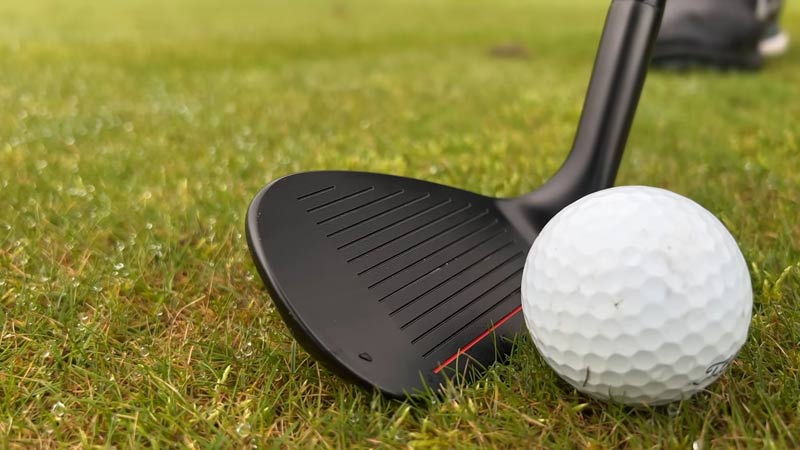When it comes to improving your golf game, the details matter, and one crucial detail often overlooked is the swing weight of your golf clubs.
If you’ve ever wondered what these mysterious letter-number combinations like D1 or C7 mean, you’re not alone. In this blog post, we’re going to demystify swing weights and explore their significance in the world of golf.
Whether you’re a seasoned pro or just starting your golfing journey, understanding how swing weights influence your clubs’ performance and feel is essential.
We’ll break down the basics, discuss the impact of swing weights on your game, and provide insights on how to determine and customize them to match your playing style. We’ll also learn everything about D1 swing weight vs D2.
By the end of this post, you’ll have a clearer understanding of this critical aspect of golf club design and be better equipped to make informed choices that can enhance your golfing experience.
What Are Swing Weights in Golf Clubs?

Swing weight in golf clubs refers to a measurement of the balance and feel of a golf club. It quantifies how the weight is distributed along the length of the club, specifically between the clubhead and the grip.
Swing weight is expressed as a letter-number combination, such as D2 or C7, with the letter indicating the position of the balance point and the number indicating the extent of the balance.
The swing weight scale typically ranges from A0 (lightest) to G9 (heaviest), with A0 being extremely light and G9 being extremely heavy.
The higher the number, the more weight is concentrated toward the clubhead, making the club feel heavier during the swing.
Swing weight affects how a golfer perceives and uses a club. Clubs with different swing weights may influence the tempo, control, and consistency of a golfer’s swing.
Golfers often choose clubs with swing weights that match their preferences and playing style.
Lighter swing weights can help with clubhead speed, while heavier swing weights may offer more control and stability. Custom fitting can ensure that golfers have clubs with the right swing weight to optimize their performance.
Swing Weight Chart
Here’s a simplified golf club swing weight chart, indicating the swing weight values typically associated with different clubs, ranging from the lightest (A0) to the heaviest (G9):
| Swing Weight | Description |
| A0 | Extremely Light |
| A1 | Very Light |
| A2 | Light |
| A3 | Slightly Light |
| A4 | Slightly Lighter |
| A5 | Balanced (Standard) |
| A6 | Slightly Heavier |
| A7 | Slightly Heavier |
| A8 | Heavy |
| A9 | Very Heavy |
| B0 | Extremely Heavy |
| B1 | Extremely Heavy |
| B2 | Extremely Heavy |
| B3 | Extremely Heavy |
| B4 | Extremely Heavy |
| B5 | Extremely Heavy |
| C0 | Extremely Heavy |
| D0 | Extremely Heavy |
| E0 | Extremely Heavy |
| F0 | Extremely Heavy |
| G0 | Extremely Heavy |
| G1 | Extremely Heavy |
| G2 | Extremely Heavy |
| G3 | Extremely Heavy |
| G4 | Extremely Heavy |
| G5 | Extremely Heavy |
| G6 | Extremely Heavy |
| G7 | Extremely Heavy |
| G8 | Extremely Heavy |
| G9 | Extremely Heavy |
Please note that this is a simplified chart, and golf club manufacturers may use variations of swing weight scales, but this should give you a general idea of swing weight values and their descriptions.
Swing Weight Calculator

A golf swing weight calculator helps determine the swing weight of a golf club based on its physical specifications.
To use one, you typically need to input information such as the club’s length, the weight of the clubhead, the weight of the grip, and the balance point (usually expressed in inches from the clubhead).
Here’s a simple formula that you can use as a basic swing weight calculator:
Swing Weight = (Clubhead Weight * Clubhead Length) / 14 + (Grip Weight * (Clubhead Length + Balance Point))
Keep in mind that this formula provides an estimate, and professional club fitters may use more advanced methods and tools for precise swing weight calculations.
Additionally, some golf club manufacturers and fitting companies offer online swing weight calculators or apps that make it easier to determine the swing weight of a club based on its specifications.
Swing Weight vs. Total Weight
Swing weight and total weight are two distinct measurements related to golf clubs, and they provide different insights into a club’s characteristics:
Swing Weight

- Swing weight is a measurement of a club’s balance and how the weight is distributed along the length of the club.
- Swing weight is usually expressed as a letter-number combination (e.g., D2, C7), with the letter indicating the position of the balance point and the number indicating the extent of the balance.
- It primarily considers the distribution of weight between the clubhead and the grip.
- Swing weight helps golfers assess how a club feels during the swing and influences the club’s playability, control, and overall performance.
Total Weight
- Total weight is a straightforward measurement of the overall mass or weight of the golf club, typically expressed in grams or ounces.
- It takes into account the weight of all components of the club, including the clubhead, shaft, grip, and any additional features like shaft extensions or counterweights.
- Total weight does not provide information about the club’s balance or how the weight is distributed within the club.
- It can influence factors like clubhead speed, club stability, and how the club feels in terms of overall heft.
Swing weight and total weight are both important considerations when customizing or choosing golf clubs, but they provide different information.
Swing weight focuses on balance and feel, while total weight provides a straightforward measurement of a club’s mass.
Both factors can impact a golfer’s performance, and finding the right balance between them is crucial for optimizing club performance and personal preferences.
Swing Weight D1 vs D2
D1 and D2 are specific swing weight measurements on the golf club swing weight scale, and they represent different club balance characteristics. Let’s learn about the concept of D1 vs D2 swing weight.
D1 Swing Weight
D1 indicates a slightly lighter swing weight on the golf club. In a D1 club, the weight distribution is such that the clubhead is relatively lighter in relation to the grip.
This can lead to a club that feels more maneuverable and may assist with generating clubhead speed. Golfers who prefer a slightly lighter feeling club during the swing may opt for D1.
D2 Swing Weight
D2 represents a slightly heavier swing weight compared to D1. In a D2 club, the weight distribution is such that the clubhead is slightly heavier in relation to the grip.
This can result in a club that feels more stable and controllable during the swing, potentially aiding in accuracy and consistency. Golfers who value control over swing speed might prefer a D2 swing weight.
The choice between D1 and D2 swing weight (or any other value on the swing weight scale) depends on a golfer’s personal preferences, swing style, and desired performance characteristics.
It’s essential to try both options and get fitted for the swing weight that aligns with your specific needs and playing style.
The Impact of Swing Weight on Your Game

Swing weight in golf clubs has a significant impact on a player’s game, influencing various aspects of performance and feel. Here’s how swing weight can affect your golf game:
Club Control
Swing weight affects the club’s overall balance, which can influence how easily you can control the club during the swing.
Heavier swing weights (higher values on the scale) can provide greater stability and control, making it easier to maintain a consistent swing path.
Distance and Speed
Lighter swing weights (lower values) may allow for a faster clubhead speed, potentially resulting in longer shots. Golfers looking to maximize distance might prefer clubs with slightly lighter swing weights.
Feel and Feedback
Swing weight significantly impacts the way a club feels during the swing. Lighter swing weights can feel more maneuverable, while heavier swing weights can feel more solid. The choice often comes down to personal preference and what feels most comfortable to the golfer.
Consistency
The right swing weight for your swing can enhance shot consistency. Clubs that match your preferred swing weight can help you produce more reliable and predictable shots.
Shot Shape
The swing weight can influence the ability to shape shots. Heavier swing weights may make it easier to control the clubhead and shape shots, while lighter swing weights might promote a straighter ball flight.
Fatigue
Using clubs with a swing weight that doesn’t match your swing can lead to fatigue during the round. Over time, trying to control clubs that feel too heavy or too light can negatively impact your performance.
Customization
Golfers can fine-tune their clubs by adjusting swing weight to better suit their preferences. Custom fitting helps ensure that each club in your bag has the desired swing weight.
Swing weight is a crucial factor in golf club selection and customization.
Finding the right swing weight that aligns with your playing style and swing characteristics can lead to improved control, distance, consistency, and overall performance on the golf course.
Custom fitting by a professional can help golfers optimize their clubs for their individual needs.
FAQs
What does d1 swing weight mean?
D1 is a measurement on the golf club swing weight scale, indicating the balance or feel of a golf club. A D1 swing weight suggests the club head is relatively lighter in relation to the grip, potentially leading to a more manageable swing.
What is the d2 swing weight?
D2 is another measurement on the golf club swing weight scale, representing the balance of a golf club.
A D2 swing weight indicates that the club head is slightly heavier in relation to the grip than D1, potentially affecting the club’s feel and performance.
What is a golf swing weight scale?
A golf swing weight scale is a tool used to measure the balance and feel of golf clubs.
It quantifies the distribution of weight in a club, with different measurements (such as D1 or D2) indicating variations in the club’s balance, allowing golfers to select clubs that suit their preferences and swing styles.
What’s the difference between total weight and swing weight?
Total weight is the overall mass of a golf club, including the clubhead, shaft, grip, and other components.
Swing weight, on the other hand, focuses on the distribution of weight between the clubhead and the grip, impacting the club’s balance and feel during the swing.
Can I change the swing weight of my golf clubs?
Yes, you can adjust the swing weight of your golf clubs through various means, such as adding lead tape or changing the grip.
Professional club fitters can help customize your clubs to match your ideal swing weight, improving your performance and comfort on the course.
Wrapping Up
In the world of golf, finding the perfect swing weight for your clubs can be a game-changer. It’s the fine-tuning that can enhance your control, increase your distance, and improve your overall game.
As we conclude this exploration into the world of swing weights, remember that they’re not one-size-fits-all. What works for one golfer may not be ideal for another.
So, take the time to understand your preferences, consider getting professionally fitted, and experiment to find that perfect balance. Your swing weights can be a hidden asset waiting to unlock your full golfing potential.
With this newfound knowledge, you’re poised to make more informed decisions about your golf equipment, putting you on the path to better swings, lower scores, and more enjoyable rounds on the course.







